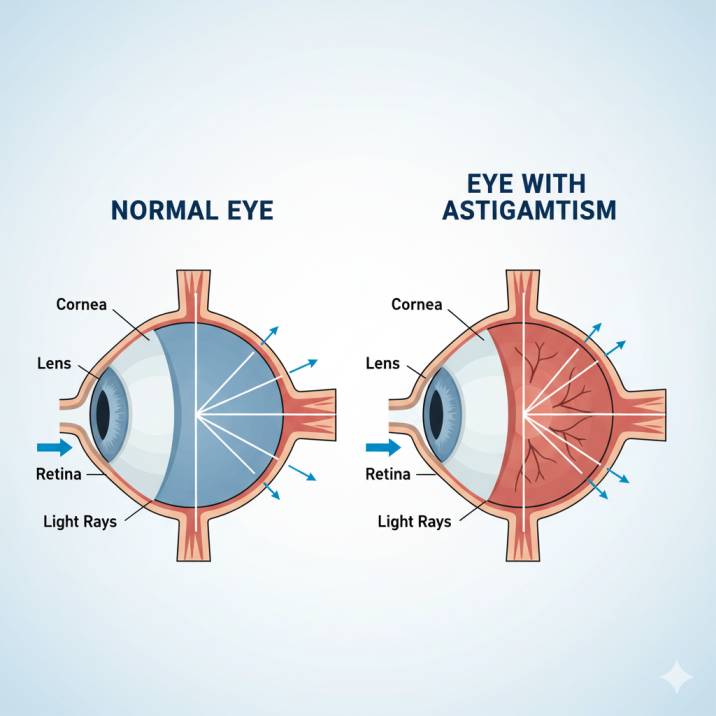Why Is My Vision Blurry? Astigmatism Treatment Guide
Have you noticed that everything looks a little blurry lately—whether you’re reading a book up close or checking a road sign in the distance? You might squint to see your computer screen clearly, or perhaps you struggle with glare and halos around streetlights at night. If this sounds familiar, you’re not alone. Astigmatism affects approximately one in three people and is one of the most common reasons people visit Fort Collins eye doctors.
The good news? Astigmatism is highly treatable, and understanding what’s causing your blurry vision is the first step toward seeing the world clearly again. At Poudre Valley Eyecare, we’ve helped Fort Collins families achieve crisp, comfortable vision for over 25 years. In this comprehensive guide, we’ll explain exactly what astigmatism is, why it makes your vision blurry, and the modern treatment options available right here in Fort Collins.
What Is Astigmatism? Understanding the Basics
Astigmatism is a type of refractive error that occurs when your eye doesn’t focus light evenly onto your retina. Think of it this way: a normal eye is shaped like a basketball—perfectly round. But an eye with astigmatism is shaped more like a football, with one meridian being more curved than the other.
This irregular curvature means that when light enters your eye, it bends unevenly and creates multiple focal points instead of one sharp focal point on your retina. The result? Blurred or distorted vision at all distances—near and far.
The Two Main Types of Astigmatism
Corneal Astigmatism: This is the most common type and occurs when your cornea (the clear front surface of your eye) has an irregular shape. Most people with astigmatism have this type.
Lenticular Astigmatism: This type happens when the lens inside your eye has an uneven curvature. It’s less common and can occur even if your cornea is perfectly round.
At Poudre Valley Eyecare, our experienced optometrists use advanced diagnostic technology to determine which type of astigmatism you have and create a personalized treatment plan.
Why Does Astigmatism Make Your Vision Blurry?
Understanding how astigmatism affects your vision helps explain why it’s such a frustrating condition. Unlike nearsightedness (where only distant objects are blurry) or farsightedness (where only close objects are blurry), astigmatism causes problems at all distances.
Here’s what happens: When your cornea or lens is irregularly shaped, light rays entering your eye don’t converge at a single point on your retina. Instead, they scatter across different areas, creating multiple focal points. Your brain receives overlapping or incomplete images, which manifests as:
- Blurred vision when looking at objects both near and far
- Distorted images or shapes that appear stretched in one direction
- Difficulty distinguishing fine details or reading small print
- Wavy or ghosted images, especially around lights
Many Fort Collins residents describe their vision with astigmatism as trying to look through a smudged or water-spotted window—no matter what they do, things just won’t come into sharp focus.
Common Symptoms of Astigmatism: Are You Experiencing These Signs?
Astigmatism symptoms can range from mild to severe, and many people don’t realize they have the condition because it often develops gradually. Here are the most common signs to watch for:
Primary Symptoms
- Blurry or Distorted Vision
This is the hallmark symptom of astigmatism. You may notice that letters appear fuzzy when reading, road signs are hard to make out, or faces look unclear even at close range.
- Eye Strain and Fatigue
Your eyes work overtime trying to compensate for unclear vision. This constant effort leads to tired, achy eyes—especially after reading, using a computer, or doing close-up work.
- Headaches
Frequent headaches, particularly around your forehead or temples, often result from your eyes straining to focus. Many of our patients report that these headaches worsen by the end of the day.
- Difficulty with Night Vision
Astigmatism significantly impacts your ability to see in low light. You might see halos, starbursts, or glare around streetlights and car headlights, making night driving particularly challenging here in Fort Collins.
- Squinting
If you find yourself constantly squinting to see better, it’s a classic sign of astigmatism. While squinting temporarily helps focus light, it’s not a solution and can lead to additional eye strain.
Recognizing Astigmatism in Children
Children often don’t realize their vision is blurry because they’ve never known what clear vision looks like. Watch for these warning signs:
- Sitting very close to the TV or holding books close to their face
- Frequent squinting or tilting their head to see better
- Complaints of headaches or tired eyes after reading
- Difficulty concentrating at school
- Rubbing their eyes frequently
At Poudre Valley Eyecare, we provide comprehensive pediatric eye exams to detect astigmatism early. Early diagnosis and treatment are crucial to prevent learning difficulties and ensure proper visual development.
What Causes Astigmatism? Understanding the Root Factors
Understanding what causes astigmatism can help demystify this common condition. Here are the primary factors:
- Genetics and Heredity
Most cases of astigmatism are hereditary. If you have astigmatism, there’s a good chance your parents or siblings do too. Research shows that astigmatism heritability ranges between 50-65%, meaning genetics play a significant role in whether you develop this condition.
- Present from Birth
Many people are born with astigmatism. In fact, a significant number of infants have some degree of astigmatism at birth, though it often improves during the first year of life as the eye continues to develop.
- Eye Injuries or Trauma
Physical trauma to the eye can alter the shape of your cornea, leading to astigmatism. This is particularly common among our Fort Collins patients who enjoy active outdoor lifestyles—from hiking and biking to sports activities.
- Keratoconus
This progressive eye disease causes the cornea to thin and bulge into a cone shape, resulting in significant irregular astigmatism. While less common, keratoconus requires specialized treatment, and our experienced team can provide the advanced care you need.
- Eye Surgery
Certain eye surgeries, particularly cataract surgery, can sometimes cause or worsen astigmatism due to the incision and healing process. However, modern surgical techniques and toric intraocular lenses can correct astigmatism during cataract surgery.
- Age-Related Changes
Astigmatism can develop or worsen as you age, particularly after age 40. The cornea and lens naturally change shape over time, which may increase astigmatism or cause it to shift from “with-the-rule” to “against-the-rule” astigmatism.
Important Note: Contrary to popular myths, astigmatism is NOT caused by reading in poor light, sitting too close to the TV, or squinting. These activities don’t create or worsen astigmatism, though they may make you more aware of existing vision problems.
How Fort Collins Eye Doctors Diagnose Astigmatism
At Poudre Valley Eyecare, we use state-of-the-art diagnostic technology combined with 25+ years of clinical expertise to accurately diagnose and measure astigmatism. Here’s what you can expect during your comprehensive eye examination:
Comprehensive Diagnostic Tests
- Visual Acuity Test
This familiar test measures how clearly you can see at various distances. You’ll read letters on a standardized eye chart, which helps us determine the degree of vision impairment caused by astigmatism.
- Refraction Assessment
Using a phoropter (that device with multiple lenses you look through), we determine your exact prescription. We’ll ask you to compare different lens options, saying, “Which is clearer, one or two?” This test precisely measures the power and axis of your astigmatism.
- Keratometry
This specialized test measures the curvature of your cornea by focusing light on your eye and measuring how it reflects. It gives us precise information about the degree and axis of your corneal astigmatism.
- Corneal Topography
For more complex cases or when considering refractive surgery, we use corneal topography to create a detailed 3D map of your cornea’s surface. This advanced technology shows even the slightest irregularities and helps us plan the most effective treatment.
- Retinal Imaging
While not specifically for astigmatism, this technology allows us to photograph the inside of your eye, ensuring there are no other underlying conditions affecting your vision. It’s part of our comprehensive approach to your eye health.
All these tests are painless and quick. Most comprehensive eye exams take about 30-45 minutes, and you’ll leave with a complete understanding of your eye health and a personalized treatment plan.
Astigmatism Treatment Options: How Fort Collins Eye Doctors Can Help You See Clearly
The excellent news is that astigmatism is highly treatable. At Poudre Valley Eyecare, we offer a full range of modern treatment options to correct your vision and improve your quality of life. Let’s explore each option:
1. Prescription Eyeglasses
Best for: Everyone with astigmatism, from mild to severe cases
Eyeglasses remain the simplest, safest, and most cost-effective treatment for astigmatism. Your prescription will include a cylindrical lens power that compensates for your cornea’s irregular shape, allowing light to focus properly on your retina.
What makes Poudre Valley Eyecare different:
- Extensive optical section with designer frames to match every style and budget
- Expert frame fitting to ensure comfort and optimal vision correction
- Advanced lens coatings, including blue-light filtering and anti-glare options perfect for Fort Collins’ bright sunny days
- We accept Medicare and Medicaid, making quality vision care accessible to everyone.
2. Toric Contact Lenses
Best for: Active individuals and those who prefer not to wear glasses
Toric contact lenses are specially designed to correct astigmatism. Unlike regular spherical contact lenses, toric lenses have different powers in different meridians to compensate for your eye’s irregular curvature.
Types of contact lenses for astigmatism:
- Soft Toric Lenses: Comfortable and easy to adapt to, these are the most popular choice for correcting mild to moderate astigmatism.
- Rigid Gas Permeable (RGP) Lenses: These provide crisper vision for higher degrees of astigmatism and may be recommended for irregular corneal astigmatism.
- Hybrid Lenses: Combining the comfort of soft lenses with the visual clarity of RGPs, these are excellent for complex prescriptions.
- Scleral Lenses: For severe irregular astigmatism or conditions like keratoconus, these large-diameter lenses vault over the cornea and provide exceptional vision correction.
Our experienced optometrists will conduct a thorough contact lens fitting to ensure proper comfort, vision, and eye health. We’ll also teach you proper insertion, removal, and care techniques.
3. Orthokeratology (Ortho-K)
Best for: Children with progressing astigmatism and adults who want clear daytime vision without lenses
Ortho-K involves wearing specially designed rigid contact lenses overnight that gently reshape your cornea while you sleep. When you remove them in the morning, you enjoy clear vision throughout the day without glasses or daytime contact lenses.
This non-surgical, reversible treatment is particularly popular among:
- Athletes and active Fort Collins residents who don’t want to worry about glasses or contacts during sports
- Children and teenagers, as it can help slow the progression of myopia (nearsightedness), along with astigmatism
- Adults who work in dusty or dry environments where contact lenses are uncomfortable
4. Refractive Surgery (LASIK, PRK, and SMILE)
Best for: Adults seeking permanent vision correction
For those looking for a long-term solution to astigmatism, refractive surgery can permanently reshape your cornea to correct vision errors. While we don’t perform surgery at Poudre Valley Eyecare, we partner with trusted Fort Collins-area surgeons and provide comprehensive pre- and post-operative care.
- LASIK (Laser-Assisted In Situ Keratomileusis)
The most popular refractive surgery, LASIK, can correct astigmatism up to approximately 6 diopters. The procedure involves creating a thin corneal flap, then using a laser to reshape the underlying tissue. Most patients achieve 20/20 vision or better, with minimal discomfort and fast recovery.
- PRK (Photorefractive Keratectomy)
Similar to LASIK but without creating a flap, PRK removes the outer layer of the cornea before reshaping it with a laser. Recovery takes longer than LASIK, but it’s ideal for patients with thinner corneas or those at higher risk for corneal trauma.
- SMILE (Small Incision Lenticule Extraction)
A newer, minimally invasive option, SMILE corrects myopia and astigmatism through a tiny 2-4mm incision. With no flap creation and less disruption to corneal nerves, SMILE offers faster healing and reduced dry eye risk compared to LASIK.
We’ll conduct a thorough pre-surgical evaluation to determine if you’re a good candidate for refractive surgery and help you understand which procedure best fits your lifestyle and visual needs.
5. Toric Intraocular Lenses (IOLs) During Cataract Surgery
Best for: Patients with cataracts and astigmatism
If you have both cataracts and astigmatism, toric IOLs offer an excellent two-in-one solution. During cataract surgery, your cloudy natural lens is replaced with an artificial lens. Toric IOLs have built-in astigmatism correction, allowing many patients to achieve clear vision without glasses after surgery.
This is particularly beneficial for our older Fort Collins patients who want to reduce their dependence on glasses while addressing age-related cataracts. We co-manage cataract surgery care with local ophthalmologists, providing comprehensive pre- and post-operative evaluations.
Living with Astigmatism: Practical Tips for Better Vision
While treatment corrects astigmatism, here are some practical strategies to protect your eye health and maximize your visual comfort:
Get Regular Eye Exams
Your prescription can change over time. We recommend annual eye exams to ensure your glasses or contacts provide optimal correction. Early detection of any changes helps prevent eye strain and headaches.
Optimize Your Lighting
Good lighting reduces eye strain. Use task lighting when reading or doing close work, and reduce screen glare by adjusting your monitor position or using anti-glare screen protectors.
Follow the 20-20-20 Rule.
Every 20 minutes, look at something 20 feet away for 20 seconds. This simple habit helps reduce digital eye strain, which is particularly important if you have astigmatism.
Protect Your Eyes from UV Rays
Fort Collins enjoys abundant sunshine year-round. Wear quality sunglasses with 100% UV protection when outdoors to protect your eyes from harmful rays and reduce glare.
Keep Your Corrective Lenses Clean
Dirty glasses or contact lenses compound the blurriness caused by astigmatism. Clean your glasses daily with proper lens cleaner and follow your eye doctor’s instructions for contact lens care.
Don’t Rub Your Eyes
Excessive eye rubbing can worsen astigmatism, particularly if you have conditions like keratoconus. If your eyes feel itchy, talk to us about underlying causes like allergies or dry eye.
When to See a Fort Collins Eye Doctor About Astigmatism
Don’t wait until your vision significantly impacts your daily life. Schedule an appointment at Poudre Valley Eyecare if you experience:
- Persistent blurry vision at any distance
- Frequent headaches or eye strain
- Difficulty seeing at night or driving after dark
- Squinting to see clearly
- Eye discomfort or fatigue after reading or screen time
- Sudden changes in your vision
Special considerations for children: Bring your child in if they exhibit signs of vision problems (squinting, sitting close to screens, complaints of headaches, or poor performance in school). Early detection and treatment are crucial for proper visual development.
The Science Behind Astigmatism: Recent Research Findings
Staying current with the latest research helps us provide you with the most effective care. Here are three significant recent studies supporting modern astigmatism treatment:
- Systematic Review on Astigmatism Epidemiology and Burden (2022)
A comprehensive systematic literature review published in Optometry and Vision Science examined the prevalence and patient burden of astigmatism. The study found that astigmatism prevalence increases significantly with age, and uncorrected astigmatism substantially impacts quality of life, work productivity, and daily activities. The research emphasizes the importance of timely screening and correction—even for mild cases—to prevent vision-related quality of life decline.
Source: Hashemi H, et al. Optometry and Vision Science. 2022.
- SMILE Surgery Outcomes for Astigmatism (2024)
A five-year follow-up study published in Ophthalmology demonstrated that 95% of SMILE patients maintained 20/20 vision or better five years after surgery for myopia with astigmatism. The research showed excellent long-term stability, low complication rates, and high patient satisfaction. This flapless procedure has emerged as a strong alternative to LASIK, particularly for patients concerned about dry eye symptoms.
Source: Liu YC, et al. Ophthalmology. 2024.
- Advances in Toric IOLs for Astigmatism Correction (2025)
Recent research published in the Journal of Cataract & Refractive Surgery examined the latest developments in toric intraocular lenses. The study found that modern toric IOLs, combined with advanced imaging and calculation methods, achieve excellent refractive outcomes with minimal residual astigmatism. Innovations in lens design and surgical techniques now allow precise correction of even complex astigmatism during cataract surgery, significantly reducing patients’ dependence on glasses.
Source: Savini G., et al. Journal of Cataract & Refractive Surgery. 2025.
These studies reinforce what we see every day at Poudre Valley Eyecare: modern astigmatism treatments are safe, effective, and life-changing for our patients.
Why Choose Poudre Valley Eyecare for Astigmatism Treatment in Fort Collins
For over 25 years, Poudre Valley Eyecare has been Fort Collins’ trusted partner for comprehensive eye care. Here’s what sets us apart:
- Quarter-Century of Excellence
With more than 25 years of experience serving Fort Collins families, we’ve built a reputation for clinical excellence and compassionate care. Our long-standing presence in the community reflects the trust our patients place in us. - Advanced Diagnostic Technology
We invest in the latest diagnostic equipment, including corneal topography and retinal imaging, to ensure accurate diagnosis and optimal treatment planning for your astigmatism. - Comprehensive Services Under One Roof
From pediatric eye care to senior services, routine exams to complex disease management, we provide comprehensive care for all ages and eye conditions. Our extensive optical section offers quality frames and lenses to suit every style and budget. - Accessibility and Affordability
We accept Medicare and Medicaid, ensuring that quality eye care is financially accessible to everyone in our Fort Collins community. We believe everyone deserves to see clearly. - Patient-Centered Care
We take time to understand your visual needs, lifestyle, and concerns. Your treatment plan is customized to your unique situation, not a one-size-fits-all approach. We explain everything clearly and answer all your questions, empowering you to make informed decisions about your eye health. - Community Connection
As a locally-owned practice, we’re deeply invested in Fort Collins’ well-being. We’re not just your eye doctors; we’re your neighbors, supporting the same community events and sharing the same local pride. - Emergency Care When You Need It
Eye emergencies don’t wait for convenient times. We offer acute care services when unexpected eye problems arise, providing peace of mind that help is available when you need it most.
References and Resources
The information in this article is supported by peer-reviewed research and authoritative medical sources. Below are three key resources cited:
-
Epidemiology and Burden of Astigmatism: Comprehensive Systematic Review
A landmark systematic literature review published in Optometry and Vision Science examined the global prevalence, patient burden, and economic impact of astigmatism. This comprehensive study analyzed 6,804 citations and included 125 studies, providing evidence that astigmatism prevalence ranges from 8-62% in the general population, with higher rates in older adults. The research also documented that uncorrected astigmatism significantly impacts quality of life, work productivity, and daily activities.
Source: Optometry and Vision Science, March 2023, Vol. 100(3), pp. 230-243
Available at: https://pmc.ncbi.nlm.nih.gov/articles/PMC10045990/
- Heritability and Genetic Factors of Astigmatism: Meta-Analysis
This 2024 systematic review and meta-analysis examined all reported heritability studies of refractive astigmatism, corneal astigmatism, and corneal curvature. Researchers analyzed data from multiple databases and confirmed moderate heritabilities of 46% for refractive astigmatism and 48% for corneal astigmatism. The study identified 50 genetic variants in 10 genes as candidate markers for astigmatism, highlighting the complex genetic architecture of this condition.
Source: American Journal of Ophthalmology, January 2025, Vol. 269, pp. 161-171
Available at: https://pubmed.ncbi.nlm.nih.gov/39216595/
- Post-Pandemic Increase in Childhood Astigmatism: JAMA Study
A groundbreaking 2025 study published in JAMA Ophthalmology examined changes in astigmatism prevalence among children after the COVID-19 pandemic. Using data from the Hong Kong Children Eye Study (21,655 participants), researchers found that refractive astigmatism prevalence increased from 23.4% before the pandemic to 34.7% in 2022-2023. The study links this increase to reduced outdoor time and increased near-work (screen time), emphasizing the importance of early detection and intervention.
Source: JAMA Ophthalmology, May 2025, Vol. 143(5), pp. 383-391
Available at: https://pubmed.ncbi.nlm.nih.gov/40111372/
Take the Next Step Toward Clear Vision
Astigmatism doesn’t have to blur your view of Fort Collins’ beautiful landscapes or interfere with your daily life. With proper diagnosis and treatment, you can enjoy crisp, comfortable vision at all distances.
Whether you’re experiencing blurry vision, frequent headaches, or difficulty seeing at night, the team at Poudre Valley Eyecare is here to help. Our experienced optometrists will conduct a comprehensive examination, accurately diagnose your astigmatism, and recommend the treatment option that best fits your visual needs and lifestyle.
Don’t let astigmatism hold you back. Schedule your comprehensive eye exam today and discover how clear, comfortable vision can transform your daily life. Contact Poudre Valley Eyecare, Fort Collins’ trusted eye care partner for over 25 years.
Ready to See Clearly?
Visit Poudre Valley Eyecare in Fort Collins today. Our caring professionals are ready to help you achieve the clear vision you deserve.
Call us or visit our website to schedule your comprehensive eye examination.
FAQs
-
Astigmatism occurs when your cornea or lens has an irregular, football-shaped curve instead of being round. This causes light to focus on two points instead of one, creating blurred or distorted vision at all distances.
Please note: None of the above should be considered medical advice. If you’re having any concerns about your vision, please reach out to us immediately or see your primary care provider.




